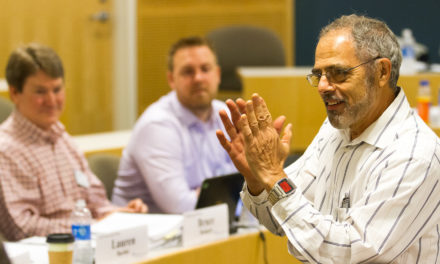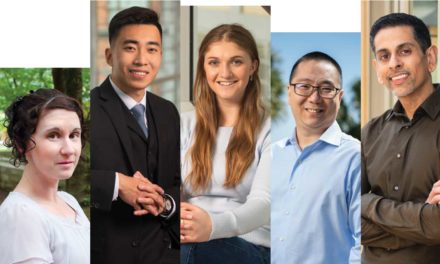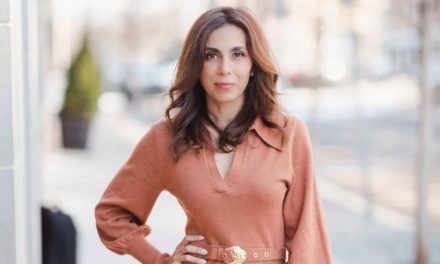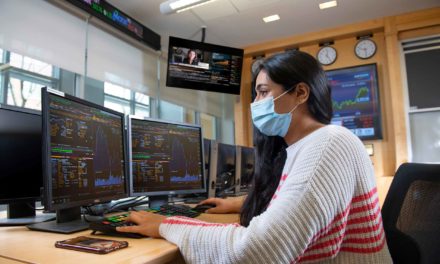How a Penn State Smeal alum overcame the unthinkable and became unstoppable.

Two pivotal moments in Brandon Lyons’ life happened on the same day, exactly three years apart. The first threatened to limit him in ways he’d never imagined. The second expanded his potential in ways he’d only dreamed.
Lyons, a 2012 Penn State Smeal graduate with a degree in supply chain and information systems and 2022 Alumni Achievement Award winner, entered college with an eye toward financial independence. “Supply chain was the No. 1 major (for job placement) within the U.S. coming out of Smeal,” he says. “I always had a goal of going to Penn State to start a career, and that’s really what drove my decision to select a major.”
Mike Poerksen, then a recruiter for Ernst & Young — and a fellow Penn Stater — saw something special in the driven student and recruited Lyons to intern at the firm during his junior year. “Brandon was so smart and likeable. He seemed to really have a focus on what he wanted to do,” says Poerksen, a 1985 graduate in accounting. “He was genuine, humble and, as we got to know each other, we learned we both have a really strong passion for our family, friends, and Penn State.”
By the time Lyons’ senior year began, he had a job lined up with Ernst & Young and a budding friendship with Poerksen. After graduating, he moved to Washington, D.C., and quickly made a name for himself at EY, earning Supply Chain Rookie of the Year honors within his first two years.
Then came May 24, 2014. Lyons was on vacation with friends in Ocean City, Maryland, when he dove off a pier into what he thought was deep water. “It was only 3 feet deep, and I came down directly on my head. I’m very fortunate I didn’t break my neck,” he says. Fully conscious and pain-free, Lyons still knew he was in big trouble. “I said to my friends, ‘I can’t stand up. I need you to pull me out of the water.’” He was airlifted to Baltimore’s R. Adams Cowley Shock Trauma Center, where he learned he had broken his T5/T6 vertebrae and was paralyzed from the chest down.
He called his mother, Kelly Bennie, while en route to the hospital. She had one thought: “Life is over.” Her only child had been athletic, independent, and happy, living with friends and excelling at a great job with a solid future. She felt all of that vanishing as she and her husband, Rhett Bennie, raced to Baltimore to be with their son.
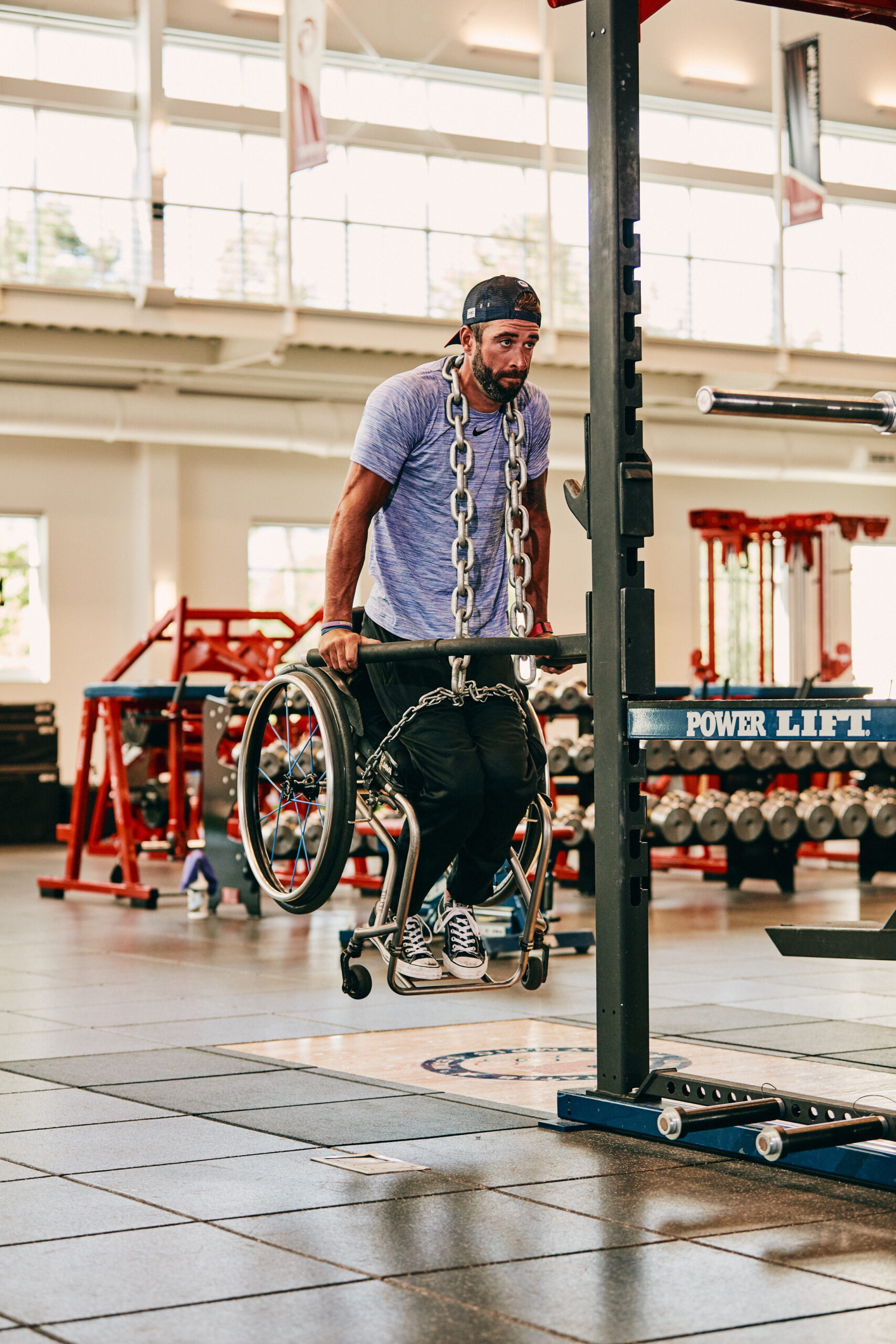
The chance to train for the national team at the U.S. Olympic and Paralympic Training Center was a dream come true for Brandon Lyons ‘12 SCIS.
“I’ve had many finish lines in my career, and it’s not only yourself getting there. I’m able to get to those finish lines with the amazing support of the people around me.”
Poerksen received a voicemail Monday morning that Rhett had sent the day before, telling him of the accident and that his young friend had been asking for him in the hospital. “I didn’t realize the severity of his injury until I got there,” says Poerksen, who brought with him the Penn State mini helmet from his Big Ten collection of them, which he left at Lyons’ bedside. “People would sign it when they came in, to let him know who was there. It was really tough at the time, but Brandon has such great family support, and a lot of great friends.”
Lyons says a chance encounter on his first day of rehabilitation therapy, just two weeks after his accident, gave him valuable perspective: He met a young woman his age who’d just had an identical accident. But her dive into shallow water had broken her neck, and she had no sensation below it. Gratefulness washed over him for the use of his upper body, and he knew one thing was certain: “I’m gonna become completely independent.”
That independence got a boost with his first handcycle, an adaptive bicycle that allows Lyons to pedal with his arms. The first time he took the bike out was mostly an exercise in frustration. “Just getting it out of the driveway was nearly impossible,” he says. But the second time he rode more than 20 miles, fueled by the joy of being active again.
The handcycle revived his athletic drive, and five months after his accident he used it to complete the Marine Corps Marathon in D.C. — his first 26.2-mile race, which he had registered to run before his injury. The handcycle’s front tire went flat at mile 13, but Lyons didn’t quit, covering the second half of the race at a 2- to 3-mph pace as Kelly, Rhett, and several others fretted, then cheered, at the finish line wearing “IRON LYONS” T-shirts.
“I’ve had many finish lines in my career, and it’s not only yourself getting there. I’m able to get to those finish lines with the amazing support of the people around me,” Lyons says. “That’s one of the biggest things I learned at Smeal — how strong the Penn State community is, and the Smeal network.”
Accomplishing a goal he’d set for himself before the accident convinced Lyons he could do anything, and his biggest objective was “full recovery.” “I saw ‘recovery’ as being the old Brandon that I was. Walking on two feet, not having to deal with any of these challenges.”
Lyons moved to San Diego to join a stem cell clinical trial; stem cells were injected directly into his spine to help him regain movement. All the while, he continued working remotely for EY, which had found a new position for him after the accident. “All of the rehab was not covered, so essentially all the money I was making funded it,” he says. After a year of not seeing the progress he’d hoped for, Lyons forced himself to consider his future in a different way. “I had this tough conversation with myself. Is all this worth it, financially and emotionally? Am I living life, or just trying to go after walking again?”
Lyons decided to think of recovery in new terms. He flew home and told his parents he was bringing his handcycle back to California. The first day he took it out in San Diego, he met another handcyclist, David Bailey. Bailey had been a motocross national champion before he was injured in an accident in 1987; in the decades since, he’d become an Ironman triathlon champion in the Physically Challenged division.
Bailey started encouraging Lyons to get more serious about the sport. The two trained together, and as Lyons’ strength and speed increased, so did his happiness. “The joy and freedom that came after I stopped worrying and focusing only on regaining the ability to walk again,” he says. “I grew a lot as a person and really understood what’s important in life.”
Poerksen noticed that untroubled spirit when he and his son joined Lyons and Rhett at the Rose Bowl in January 2017, when Penn State played USC. “Brandon was actually our driver,” says Poerksen, impressed with the adaptive equipment Lyons had installed in his vehicle to allow him to drive.
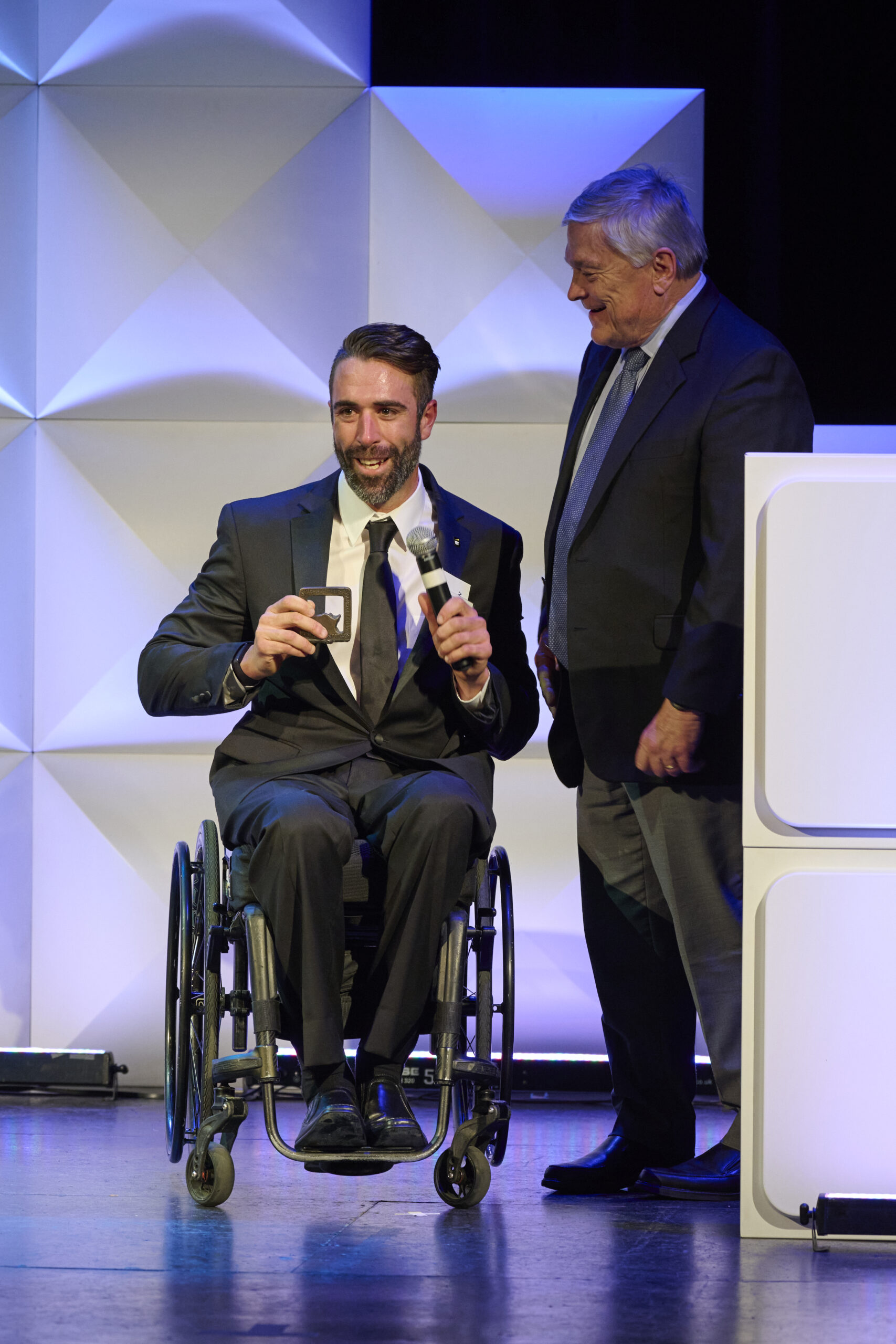
Credit: Steve Tressler
In March 2022, Lyons returned to his alma mater to receive an Alumni Achievement Award, which recognizes Penn State graduates age 35 and younger for extraordinary professional accomplishments. Lyons is shown here with Penn State President Emeritus Eric J. Barron.
Later that year, Lyons was invited to become a full-time resident at the U.S. Olympic & Paralympic Training Center in Colorado Springs, Colorado, the first handcyclist to earn such a spot. The chance to train for a place on the national team was a dream come true, and he moved in on May 24, 2017 — exactly three years after the accident that had put him on that bike.
From mid-2017 until the pandemic forced the cancellation of competitions in 2020, Lyons worked part-time for EY and trained full-time with a single-minded focus: Tokyo. “He’d turn away from potential (stem cell) clinical trials,” says Bennie. “He’d just say, ‘I’m focused on Tokyo 2020.’”
His ability to pivot to new goals and different dreams when the originals no longer served him was making all the difference. In 2019, Lyons qualified for his first national team and won two silver medals at the Parapan American Games, a silver at the Paracycling World Championship, and multiple medals at the UCI World Cup and National Championships. After the Tokyo games were postponed a year and the training center shut down due to COVID-19 restrictions, Lyons moved to St. Augustine, Florida, to be near his mom and stepdad. He bumped back up to full-time work at EY, where he is now an assistant director within the Americas Experience Management Center of Excellence.
The Alumni Achievement Award, given to him and a handful of others 35 years of age and younger for their extraordinary professional accomplishments in a ceremony at University Park in March, was an unexpected honor that he says validated both his hard work and overarching goal. “It was a very exciting and humbling experience, particularly being at the event and seeing some of the accomplishments of the other recipients. It kind of proved what I’ve tried to set out to do. I didn’t want my injury to prevent me from continuing to succeed in my professional or personal life.”
Nor did he let the pandemic hamper his drive. Lyons kept training, and by the spring of 2021 was in peak physical condition and laser-focused on Tokyo. Unfortunately, an undetected infection progressed to the early stages of sepsis just before the Paralympic Trials, knocking him out of contention for the U.S. team.
“I wasn’t down or saying, ‘Why me?’ I was in a good headspace,” says Lyons. “It pushed me to come back and train for 2022 and go after Paris 2024. I qualified again for the national team this year, so it’s all coming full circle.”
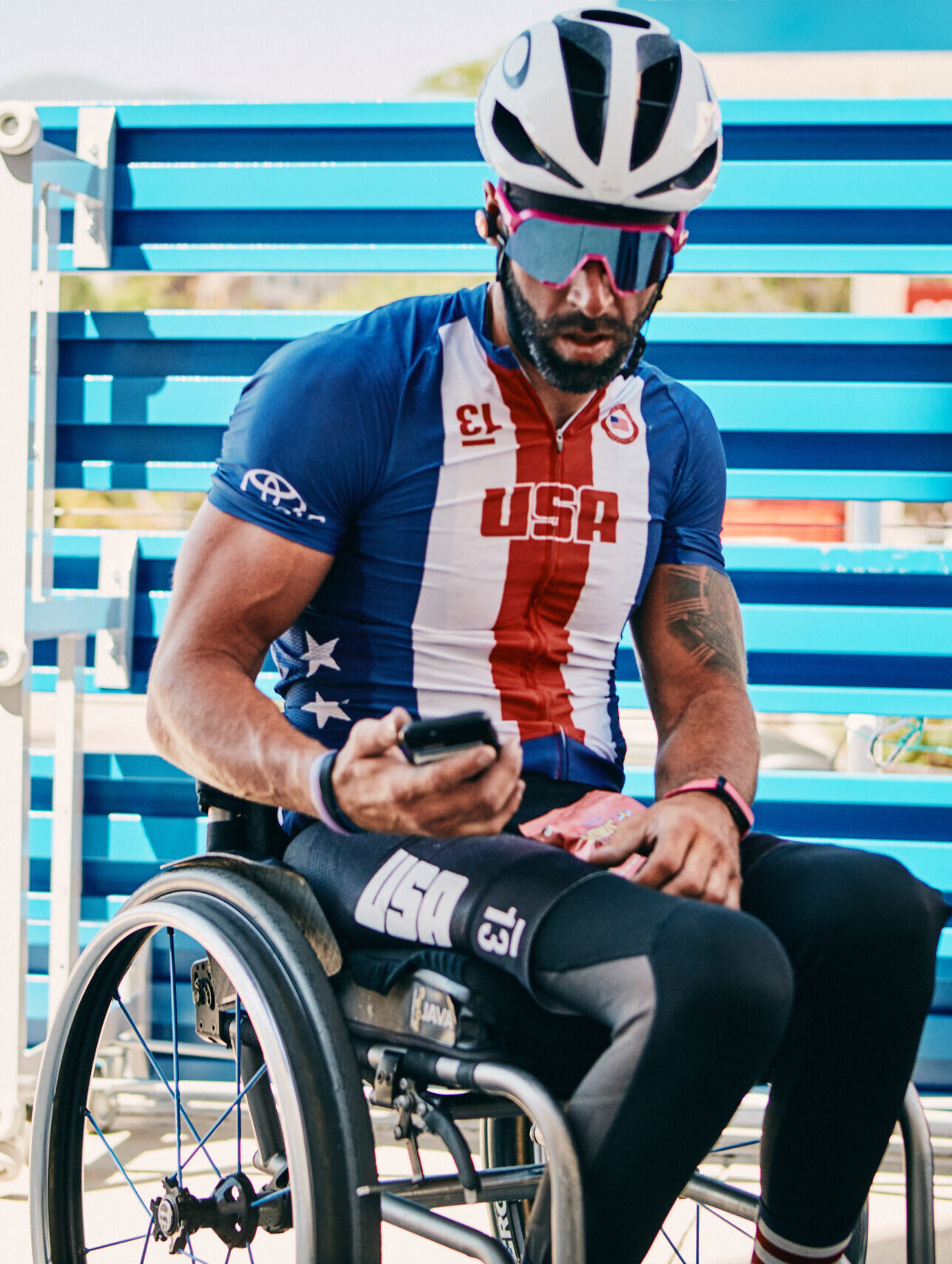
In 2019, Lyons qualified for his first national team and won two silver medals at the Parapan American Games, a silver at the Paracycling World Championship, and multiple medals at the UCI World Cup and National Championships.
In the season opener in April, Lyons took silver in the time trial, bronze in the road race, and gold in team relay, punching his ticket to represent Team USA in the first two World Cups, held in Europe.
When asked if he had any advice for Smeal students or alumni who face seemingly insurmountable challenges, the athlete-slash-executive’s response is quick and confident: “Don’t allow anyone, but most importantly yourself, to place any limits on what you think is possible,” he says. “It’s very easy as you’re going through a challenge to give up and say it’s too difficult. But when you embrace the uncomfortable, you have a lot of opportunities to grow. Some of those darkest times can lead to the best experiences of your life.”
That attitude, relentless goal setting and determined follow-through will continue to fuel whatever he sets his mind on next. “I’ve had so many people place limits on myself,” he says, “and that’s the biggest motivator for me. Proving them wrong is also proving myself right.”
![Lyons Garden of the Gods[2]](https://magazine.smeal.psu.edu/wp-content/uploads/2022/06/Lyons-Garden-of-the-Gods2-scaled.jpg)
Credit: Stephen Martin
